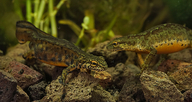|
Lissotriton montandoni (Boulenger, 1880)
Carpathian Newt Subgenus: Lissotriton | family: Salamandridae subfamily: Pleurodelinae genus: Lissotriton |
 © 2017 Henk Wallays (1 of 81) |
|
|
|
Description Distribution and Habitat Country distribution from AmphibiaWeb's database: Czech Republic, Poland, Romania, Slovakia, Ukraine
Life History, Abundance, Activity, and Special Behaviors Daily activity is similar to that of other newts of the genus Triturus. However, terrestrial adults are active during the daytime more often than other newts. They may be found crawling on open ground in sunlight at air temperatures of +20 degrees Celsius. Hibernation starts in late October and, at low altitudes, finishes in late March to April, compared to May or early June in the highlands. Usually, reproduction peaks in May, or through June in the highlands. Courtship is most similar to that of Triturus vulgaris. Embryogenesis takes 10-15 and perhaps up to 30 days. Metamorphosis is completed after 70-90 days. Newly metamorphosed efts appear usually in the second half of July. In the highlands, larvae sometimes overwinter. After the transition to active feeding, T. montandoni larvae primarily eat microcrustaceans with a small addition of insects. Afterwards, their diet becomes richer in insects and molluscs. Juveniles use only terrestrial prey, including Oniscidae, Acarina, Pseudoscorpiones, Oniscomorpha, Simphyla and Collembola (Sminthuridae, Entomobryidae and Isotomidae). The prey of terrestrial adults is larger and more diverse including Lumbricidae, Mollusca, Lithobiomorpha, Juliformia, Coleoptera, ants, imago and larvae Lepidoptera and Diptera. Some groups of small prey used by the juveniles (Symphyla, Oniscidae, Oniscomorpha and Isotomidae) are not used by the adult newts coexisting with them. This reflects increasingly selective feeding on large prey in the newts' postmetamorphic development and a corresponding decrease of selectivity to small prey. Natural enemies of the Carpathian Newt are poorly known. Apparently, cannibalism in the form of the oophagy on nesting sites is common in the newt populations. Relation to Humans
References
Bannikov, A. G., Darevsky, I. S. and Rustamov, A. K. (1971). Zemnovodnye i Presmykayushchienya SSSR [Amphibians and Reptiles of the USSR]. Izdatelistvo Misl, Moscow. Bannikov, A. G., Darevsky, I. S., Ishchenko, V. G., Rustamov, A. K., and Szczerbak, N. N. (1977). Opredelitel Zemnovodnykh i Presmykayushchikhsya Fauny SSSR [Guide to Amphibians and Reptiles of the USSR Fauna]. Prosveshchenie, Moscow. Gasc, J. P. , Cabela, A., Crnobrnja-Isailovic, J., Dolmen, D., Grossenbacher,K., Haffner, P., Lescure, J., Martens, H., Martinez Rica, J. P.,Maurin, H., Oliveira, M. E., Sofianidou, T. S., Vaith, M., and Zuiderwijk, A. (1997). Atlas of Amphibians and Reptiles in Europe. Societas Europaea Herpetologica and Muséum National d’Histoire Naturelle, Paris. Griffiths, R.A. (1996). Newts and Salamanders of Europe. T. and A. D. Poyser, London. Kuzmin, S. L. (1995). Die Amphibien Russlands und angrenzender Gebiete. Westarp Wissenschaften, Magdeburg. Kuzmin, S. L. (1999). The Amphibians of the Former Soviet Union. Pensoft, Sofia-Moscow. Nöllert, A. and Nöllert, C. (1992). Die Amphibien Europas. Franckh-Kosmos Verlags-GmbH and Company, Stuttgart. Szczerbak, N. N. and Szczerban, M. I. (1980). Zemnovodnye i Presmykayushchiesya Ukrainskikh Karpat [Amphibians and Reptiles of Ukrainian Carpathians]. Naukova Dumka, Kiev. Zavadil, V. and Dandova, R. (1995). Bibliogtrafie colka karpatskeho: Fauna Bohemiae Septentrionalis 20 (Usti nad Labem). Originally submitted by: Sergius L. Kuzmin (first posted 1999-10-06) Edited by: Sean Schoville (1/18/00) Species Account Citation: AmphibiaWeb 1999 Lissotriton montandoni: Carpathian Newt <https://amphibiaweb.org/species/4301> University of California, Berkeley, CA, USA. Accessed Jun 15, 2025.
Feedback or comments about this page.
Citation: AmphibiaWeb. 2025. <https://amphibiaweb.org> University of California, Berkeley, CA, USA. Accessed 15 Jun 2025. AmphibiaWeb's policy on data use. |


 Raffaëlli Account
Raffaëlli Account Map of Life
Map of Life